Related Research Articles

Chagas disease, also known as American trypanosomiasis, is a tropical parasitic disease caused by Trypanosoma cruzi. It is spread mostly by insects in the subfamily Triatominae, known as "kissing bugs". The symptoms change over the course of the infection. In the early stage, symptoms are typically either not present or mild, and may include fever, swollen lymph nodes, headaches, or swelling at the site of the bite. After four to eight weeks, untreated individuals enter the chronic phase of disease, which in most cases does not result in further symptoms. Up to 45% of people with chronic infections develop heart disease 10–30 years after the initial illness, which can lead to heart failure. Digestive complications, including an enlarged esophagus or an enlarged colon, may also occur in up to 21% of people, and up to 10% of people may experience nerve damage.
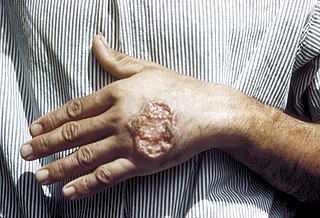
Leishmaniasis is a wide array of clinical manifestations caused by protozoal parasites of the Trypanosomatida genus Leishmania. It is generally spread through the bite of phlebotomine sandflies, Phlebotomus and Lutzomyia, and occurs most frequently in the tropics and sub-tropics of Africa, Asia, the Americas, and southern Europe. The disease can present in three main ways: cutaneous, mucocutaneous, or visceral. The cutaneous form presents with skin ulcers, while the mucocutaneous form presents with ulcers of the skin, mouth, and nose. The visceral form starts with skin ulcers and later presents with fever, low red blood cell count, and enlarged spleen and liver.

Carlos Justiniano Ribeiro Chagas, or Carlos Chagas, was a Brazilian sanitary physician, scientist, and microbiologist who worked as a clinician and researcher. Most well known for the discovery of an eponymous protozoal infection called Chagas disease, also called American trypanosomiasis, he also discovered the causative fungi of the pneumocystis pneumonia. He described the two pathogens in 1909, while he was working at the Oswaldo Cruz Institute in Rio de Janeiro, and named the former Trypanosoma cruzi to honour his friend Oswaldo Cruz.

Adolfo Lutz was a Brazilian physician, father of tropical medicine and medical zoology in Brazil, and a pioneer epidemiologist and researcher in infectious diseases.

The members of the Triatominae, a subfamily of the Reduviidae, are also known as conenose bugs, kissing bugs, or vampire bugs. Other local names for them used in the Americas include barbeiros, vinchucas, pitos, chipos and chinches. Most of the 130 or more species of this subfamily feed on vertebrate blood; a very small portion of species feed on invertebrates. They are mainly found and widespread in the Americas, with a few species present in Asia and Africa. These bugs usually share shelter with nesting vertebrates, from which they suck blood. In areas where Chagas disease occurs, all triatomine species are potential vectors of the Chagas disease parasite Trypanosoma cruzi, but only those species that are well adapted to living with humans are considered important vectors. Also, proteins released from their bites have been known to induce anaphylaxis in sensitive and sensitized individuals.
Since October 2018, the Center for Global Infectious Disease Research has been part of the Seattle Children's Research Institute. At the time of the merger, CID Research had 166 scientists. Its mission was to eliminate the world's most devastating infectious diseases through leadership in scientific discovery. The organization's research labs were in the South Lake Union area of Seattle, WA. The institute's research focused on four areas of infectious disease: HIV/AIDS, malaria, tuberculosis (TB), and Emerging & Neglected Diseases (END) like African sleeping sickness, leishmaniasis, Chagas disease, and toxoplasmosis. CID Research was engaged in early stages of the scientific pipeline including bench science and malaria clinical trials and has expertise in immunology, vaccinology, and drug discovery.
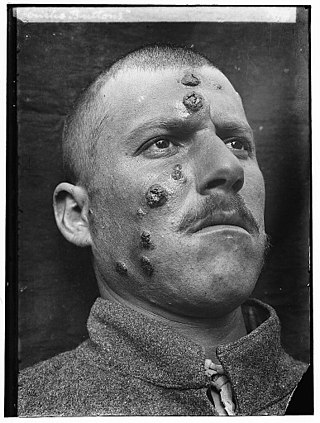
Cutaneous leishmaniasis is the most common form of leishmaniasis affecting humans. It is a skin infection caused by a single-celled parasite that is transmitted by the bite of a phlebotomine sand fly. There are about thirty species of Leishmania that may cause cutaneous leishmaniasis.

São Paulo State University is a public university run by the state government of São Paulo, Brazil.

Carlos Chagas Filho was a Brazilian physician, biologist and scientist active in the field of neuroscience. He was internationally renowned for his investigations on the neural mechanisms underlying the phenomenon of electrogenesis by the electroplaques of electric fishes. He was also an important scientific leader, being one of the founders of the Biophysics Institute of the Federal University of Rio de Janeiro and was also a president for 16 years of the Vatican's Pontifical Academy of Sciences, and president of the Brazilian Academy of Sciences (1965–1967).
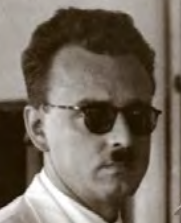
Evandro Serafim Lobo Chagas the eldest son of Carlos Chagas (1879-1934), noted physician and scientist who discovered Chagas disease, and brother of Carlos Chagas Filho (1910-2000), also a noted physician and scientist who was president of the Pontifical Academy of Sciences.

The Phlebotominae are a subfamily of the family Psychodidae. In several countries, their common name is sandfly, but that name is also applied to other flies. The Phlebotominae include many genera of blood-feeding (hematophagous) flies, including the primary vectors of leishmaniasis, bartonellosis and pappataci fever. In the New World, leishmaniasis is spread by sand flies in the genus Lutzomyia, which commonly live in caves, where their main hosts are bats. In the Old World, sand flies in the genus Phlebotomus spread leishmaniasis.

The Drugs for Neglected Diseases initiative (DNDi) is a collaborative, patients' needs-driven, non-profit drug research and development (R&D) organization that is developing new treatments for neglected diseases, notably leishmaniasis, sleeping sickness, Chagas disease, malaria, filarial diseases, mycetoma, paediatric HIV, cryptococcal meningitis, hepatitis C, and dengue. DNDi's malaria activities were transferred to Medicines for Malaria Venture (MMV) in 2015.

Protozoan infections are parasitic diseases caused by organisms formerly classified in the kingdom Protozoa. These organisms are now classified in the supergroups Excavata, Amoebozoa, Harosa, and Archaeplastida. They are usually contracted by either an insect vector or by contact with an infected substance or surface.
Salvador Mazza was a noted Argentine physician and epidemiologist, best known for his strides in helping control American trypanosomiasis, an endemic disease among the rural, poor majority of early 20th century South America.
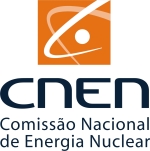
The National Nuclear Energy Commission is the Brazilian government agency responsible for orientation, planning, supervision, and control of the Brazil's nuclear program. The agency was created on 10 October 1956. The CNEN is under the direct control of the Ministry of Science and Technology.
Rhodnius nasutus is a Chagas disease vector native to the northeast of Brazil. It belongs to the family Reduviidae and subfamily Triatominae, which are commonly known as "kissing bugs" or "assassin bugs". They are considered a highly important species concerning the infectious Chagas disease as they carry the parasite Trypanosoma cruzi, that can be transmitted to the blood of mammals, including humans. This disease is an important issue in Brazil and central America due to the large number of Rhodnius species inhabiting these areas, however in recent efforts to reduce human infection, multiple variations of pesticides have dramatically reduced Triatomine populations. Therefore, the understanding and knowledge of Rhodnius nasutus greatly benefits our efforts in reducing life threatening infections.

The Ministry of Health is a cabinet-level federal ministry in Brazil. Since January 2023, the Health Minister is Nísia Trindade, a researcher and former chairwoman of Oswaldo Cruz Foundation.
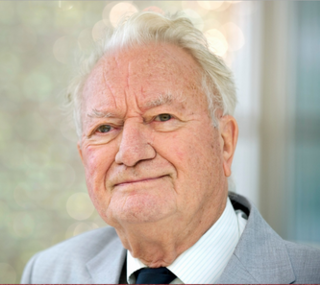
Ralph Lainson OBE, FRS was a British parasitologist who studied leishmaniasis in Brazil. He was the first to publish a record of Chagas disease.
Mundo Sano, or Fundación Mundo Sano, is a scientific, nongovernmental foundation in Argentina working for the prevention and control of communicable diseases such as dengue fever, Chagas disease, malaria, leishmaniasis and soil-transmitted helminthiasis. Its main objective is to facilitate equal access to health and welfare among people who are vulnerable to these otherwise avoidable diseases, mainly by promoting strategic policies for the improvement of the quality of life of affected communities.

Jeffrey Jon Shaw OBE, FLS, FASTMH is a British parasitologist who began working in Latin America in 1962. Although officially retired, he is presently Senior Professor at São Paulo University's Biomedical Sciences Institute where he continues his research in its Parasitology Department.
References
- ↑ Benchimol, Jaime Larry. "Leishmaniases of the New World from a historical and global perspective, from the 1930s to the 1960s". História, Ciências, Saúde-Manguinhos. 27: 95–122. doi: 10.1590/s0104-59702020000300006 . ISSN 0104-5970.
- ↑ "History". About IEC. Evandro Chagas Institute. Archived from the original on 6 July 2011. Retrieved 12 December 2010.